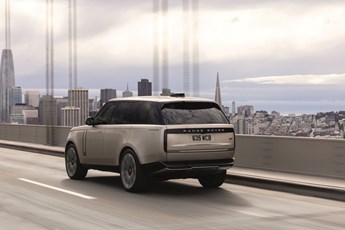We use cookies to ensure that we give you the best experience on our website. If you continue without changing your settings, we will assume that you are happy to receive all cookies on the Business Car website. However, if you would like to, you can change your cookies at any time

The start point for the best source of fleet information |
First drive: Range Rover
Date: 15 June 2022 | Author: Guy Bird

|
|
||||||||||||||||||||
The 2022 Range Rover is aptly-named. Now with a seven-seat option for the first time, as well as four- and five-seater models, short and long wheelbases, two power ratings in diesel, petrol and PHEV - the latter offering a very useful 70 miles of electric-only range - and a full-electric version due in 2024, the car has a lot to offer. Not forgetting an SV version offering more accessory options than Kylie Jenner's no doubt expansive wardrobe could possibly accommodate, the mk5 is so much than a single model and definitely more of a range.
Range Rovers don't come around that often - the 2022 version is only the fifth in just over five decades - so like other cars that have become iconic in their sectors, new ones tend to be evolutionary. The Range Rover mk5 still looks like an upright SUV with large windows, good sight lines, smooth sides and that signature gentle uptick at the lower part of its tail. But it doesn't look like the Mk4, due to much slimmer and vertical rear lights neatly joined together by a Range Rover-badged cross bar. No-one will mistake it for an older model, or indeed any other luxury SUV.
A great deal of time was spent raising the bar inside too. Range Rover hired a former Rolls-Royce designer to lead the interior and it shows. Where the mk4 had a smaller, integrated screen, the new mk5's 13.1ins screen is bigger, floating, curved, more intuitive and responsive, while the steering wheel controls feature capacitive elements. In the second row, seats recline gently and there is a tray table option, which wouldn't look out of place within the Business Class section of a modern plane, plus a complex motorised central cup-holder area. The third row seating in the seven-seat version is 'stadium style' - sitting slightly higher than the second row - and although access isn't quite as easy or glamorous as the first and second rows, once inside, space is fine and ambience decent. You don't feel like you're sitting in a boot. Another example of a high-end functional feature usually only found on the highest-priced luxury models, is Range Rover's new 'event seating' - rear-facing, boot-mounted pop-up seats. Deployed when the car is stationary, when folded flat they don't rob usable boot space. Depending on the model, luggage litres range from 312 on the seven-seater with the third row upright, rising to 2601 on the LWB version, all rows folded.
At the early launch, only a few engine and size options were available to test: a 530hp 4.4 V8 in SWB and LWB, plus a 350hp 3.0-litre MHEV SWB. All fall firmly within the 37% BIK tax band. The V8 is more punchy and rapid but with weaker economy (4.6sec 0-62mph and 24.8mpg) while the top-end 350hp diesel offers more solidity and relative economy (6.1sec 0-62mph and 30.8mpg) but is still very quiet and refined. Cornering is tidier than predecessor models, but a 2.5-tonne vehicle will inevitably pitch a little if driven fast a lot. Its off-load skills and tech are a true cut above as ever, with features we've become used to, like wade sensing and ride height adjustment up to 135mm (or down to 50mm). Lower-powered 300hp diesel and 400hp 3.0-litre petrol versions are also options for the UK market, but the only decent tax or economy breaks come with the 440 and 510hp 3.0-litre petrol/electric plug-in versions. Both models' 19g/km CO2 ratings fall in the 5% BIK band and offer more power than the diesels, but cost more too. Middle HSE spec for the P440e is £109,275 and P510e £114,325 respectively (compared to £108,775 for the D350 HSE SWB).
Due to a circa £5k hike across the board announced soon after the original prices, almost the whole range now starts above £100k, beginning at £99,375 for the D300 SE SWB rising to a whopping £178,220 for the P530 SV LWB. That's big money, but not compared to say, a Lamborghini Urus or a Bentley Bentayga. And the Range Rover, now more than ever, occupies a more civilised and refined position, more suitable and in-keeping for a bluechip company md, CEO or similar and his or her decent size family. It's a great range already, and when the full-electric version arrives in 2024, the Range Rover mk5 will truly have all bases covered.
Range Rover D350 MHEV HSE SWB
P11D: £112,500
Residual value: 49.73%
Depreciation: £56,546
Fuel: £13,667
Service, maintenance and repair: £5,005
Cost per mile: 125.36p
Fuel consumption: 30.8mpg
CO2 (BIK %): 205g/km (37%)
BIK 20/40% a month: £662/£1,279
Luggage capacity: 725 litres
Engine size/power: 2,997cc/350hp
Verdict |
9/10 |
|||
 |
|
 |
|
|











